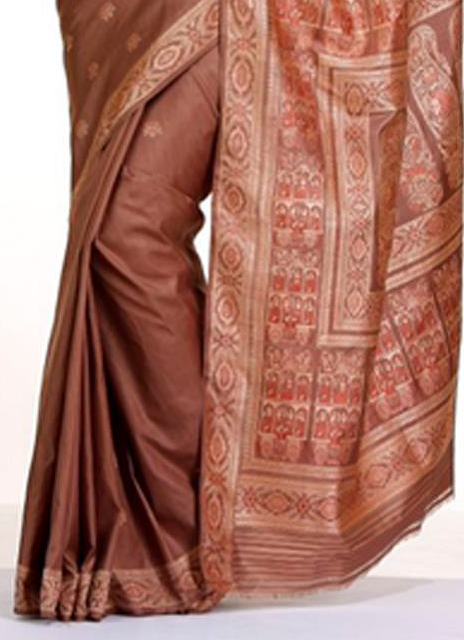Baluchari Silk Saree
Baluchari Silk Saree
Back ground
This fabric is named after the village ‘Baluchar’ located on the bank river of Bhagirathi in Murshidabad district, West Bengal and presently known as Jiaganj. Baluchari weaving was flourished during the period of Musid Quli Khan, the Diwan of Bengal, an erstwhile Hindu Bramin who embraced Islam and these textiles are famous for their elaborate ‘anchal’ (palloo). It has been eulogized as the “loveliest and most charming of all silks of India”.
It is a highly decorative silk fabric having extra weft on ‘palloo’, border and body. The motifs are mainly derived from then social / religious customs, animals, life styles of people etc. For example man smoking hukkah, lady with flower, man riding horse, chariot, marriage, mosque, temple, vignettes from Ramayana etc. are some of the motifs generally used and organize in narrative style in palloo portion. And the important feature of the technique is the white outlining of the motifs. Also paisley motifs are arranged centrally in the palloo portion and all over ‘butties’ are in the body portion.

Materials used
Murshidabad variety of less twisted mulberry silk yarn was originally used in Baluchari sarees. Coarser silk varieties like matka silk was also used some time back. Later, it has been replaced by 18/20 D (2ply) organzine silk yarn for warp and single yarn of malda variety mulberry silk in 3 ply is used for weft. 96s to 100s steel reed is normally used for Baluchari saree weaving and the extra warp designs are woven with Jacquards replacing’ Jala’ technique of olden days.
Weaving technique
Main feature of Baluchari Sari is the arrangement of design in palloo by maintaining the corner and cross border perfectly in boxes ‘Jala’ technique was originally followed by Baluchari weavers in those days.
Presently Baluchari fabrics are woven in Bishnupur of Bankura district with jacquards and the designs are from the influence of motifs of ‘terracotta’ temples in Bishnupur. The pictorial element of these sarees retain a degree of continuity and evidence of assimilation of diverse cultures giving rise to a distinctive art form that was accommodative and secular. Double Jacquards are used for palloo and borders and weavers are expert in graph making and punching of design cards.
How to distinguish genuine Balucharil Saree
- Baluchari silk sarees can easily be identified from the construction of long palloo and placement of its design motifs in perfect rectangular closed corners maintain continuity of the designs without break.
- Basic fabric is heavier and more compact than Banarasi Saree.
- Designs are made with extra weft using silk yarn. No jari is used as done in Banarasi or other silk saree.
Source : Indian Handloom Brand
Last Modified : 9/4/2023
This topic provides information about Woolen Stole...
The Department of Labour seeks to enforce labour l...
Assistance for folk artists of West Bengal
The objective of the Scheme is to assist validly r...
